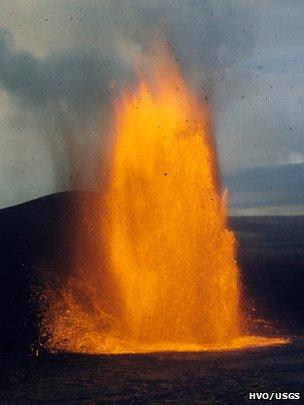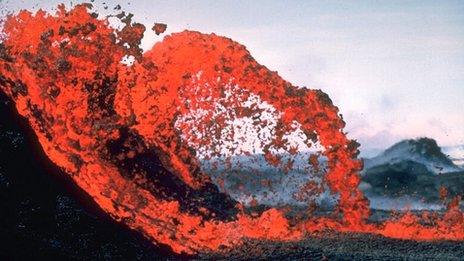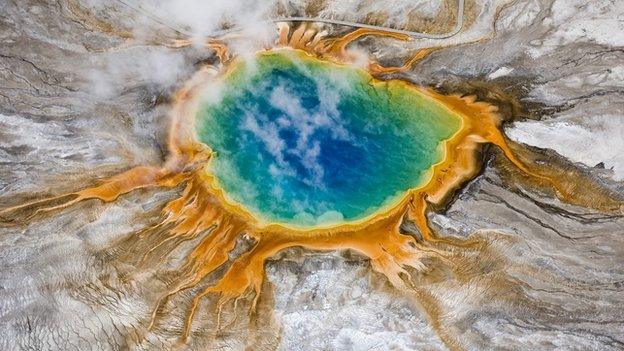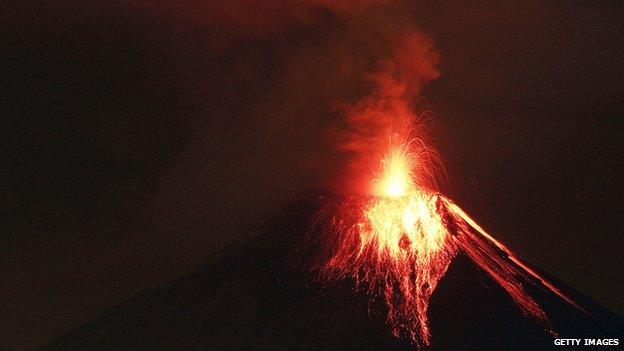Volcano eruptions have deep origins
- Published

The ferocity of Kilauea's eruption is linked to the chemical balance in the mantle below
Hawaiian volcanoes sometimes erupt as gentle flows of lava, but other times produce spectacular lava fountains.
New data from centuries-worth of eruptions suggest that the differences reflect fluctuations deep in the Earth.
Reporting in the journal Nature Geoscience, external, scientists considered how magma rich in volatile elements rises rapidly and erupts as high fountains.
Historical eruptions follow variations in the chemistry of Earth's deep mantle, they report.
If you travel to Tokyo, Mexico City, Seattle or Naples, all cities sitting "under the volcano", a short journey out of town will take you to the slopes of a dormant monster.
Understanding the hows and whys of volcanic eruptions is crucial if these types of geohazard are to be properly assessed.
History suggests that the consequences of huge volcanic explosions may extend from local disaster to global catastrophe.
Spectacular shows
We learned in recent years how volcanic ash can disrupt holiday flights and cause short-lived misery. But evidence from the deep geological past implies that volcanic activity could be linked to mass extinctions, or at least significant global environmental change.

Kilauea's eruptions are sometimes spectacular, sometimes gentle
A team of volcano experts from Cambridge University and Hawaii have looked at the rocks erupted from the ocean island volcano of Kilauea, Hawaii, in 25 historical eruptions that have occurred over the last 600 years.
Kilauea is active, fed by magma from deep beneath Earth's rocky crust in a region called the mantle.
Sometimes the volcano erupts gently, with dribbles of lava running down the mountain's flanks, while other times she throws fountains of lava high into the sky, or produces curtains of fiery rock in a spectacular show.
Even the gentle lava flows pose problems for local residents, however. Just this week the Hawaiian Volcano Observatory (HVO) reported on a river of lava that is slowly flowing from Kilauea volcano's east rift zone towards the community of Puna.
Up to now, the assumption has been that the differences in volcanic eruption style can be attributed to differences in how quickly the molten rock reaches the surface, or whether the gas it contains can escape gently ahead of the magma on its ascent. But new evidence suggests that what controls these eruptions sits deeper still.
By measuring the chemistry of the original molten rock associated with each eruption, now preserved as glassy blobs in the volcanic mineral grains, the scientists found that energetic eruptions and gentler "effusive" eruptions seem to have come from areas of the mantle with subtly different chemistries.
Describing their results, lead investigator Dr Marie Edmonds of Cambridge University told BBC News: "The chemistry of the primitive melts feeding the explosive eruptions appears statistically different to those feeding effusive eruptions.
"We think that these primitive melts may saturate with gases and grow their bubbles deep in the system, accelerate towards the surface to a greater degree and bypass the summit magma chamber, erupting more explosively at the surface.
"This work is the first to show a link between the nature of the melts produced in Earth's mantle, and variations in surface eruption styles. It has important implications for volcano monitoring and hazard assessment."
The data suggest that the changes in eruption reflect subtle local variations in the chemistry of Earth's mantle occurring over decades to centuries.
The team believe that a better understanding of these variations will improve volcanic hazard assessment and perhaps land use planning and risk management over similar timescales.
- Published7 December 2011

- Published6 January 2014

- Published9 July 2012
